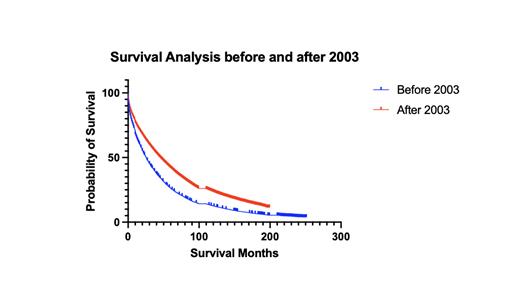Introduction:
Multiple Myeloma (MM) is a hematologic malignancy of plasma cells. Over the last couple of decades, there have been groundbreaking advances in its treatment, emergence of chimeric antigen receptor T-cell (CAR-T) therapies and bispecific antibodies (bsAbs). As per National Comprehensive Cancer Network's (NCCN) current guidelines, the current standard of treatment is a 3-drug regimen bortezomib/lenalidomide/dexamethasone. The year 2003, marked the beginning of the revolution in the MM biological treatment. The aim of this retrospective study is to analyze the trends of multiple myeloma, particularly to assess the difference in survival, with the innovation in its novel treatment options.
Methods:
The data was collected from Surveillance, Epidemiology and End Result database Research. We extracted Multiple Myeloma cases diagnosed between 01-85+ years of age, using Incidence- SEER Research Date 17 Registries, Nov 2022 Sub (2000-2020), with ICD 0-3 Hist/behavior, malignant, code 9732/3 for plasma cell myeloma. The analysis was stratified based on age, sex, race, & survival curves based were compared, using the Log-rank test (GraphPad Prism).
Results:
A total of 109222 cases of multiple myeloma were identified between 2000-2020. Of these, ~55.18% were males and ~44.81% were females. Median age at the time of diagnosis is 69 years. The incidence rate overall has been increasing and was noted to be 62.38 per 1,000,000 population vs 56.38 in the year 2000. When stratified further on gender, incidence rates for males were noted to be up-trending from 69.32 in 2000 to 75.87 in the year 2020. Whereas for females the incidence rates in females in 2000 was at 47.02 and at 51.51 in 2020. The survival was compared for the general population before and after the emergence of newer treatment in the year 2003. There was a statistical difference found in the median of survival (mOS) before the introduction of the biologicals in 2003, was 25 months, and after the year 2003, was 46 months (P Value <0.0001, Hazard Ratio 1.451 95% Confidence Interval 1.421 to 1.481).
Conclusion:
Multiple Myeloma is a relatively rare malignancy, with a slightly stronger male predilection. Its overall incidence has been noted to be up-trending within the last 20 years, in the United States. The median age for diagnosis is 69 years. In the year 2003, FDA approved Bortezomib for the treatment of MM, which primarily targeted the proteasome and the ubiquitin proteasome system (UPS). This established the role of UPS in MM, and further led to the invention of newer biological treatment options for MM. When survival months were compared in the pre-and-post biological treatment era, it was noted that the mOS was only 25 months, whereas a significant increase in mOS to 46 months was noted, after the introduction of biological therapy in 2003. With newer groundbreaking research and approval of CAR-T therapies, we are on our way to making MM, a curable malignancy.
Disclosures
No relevant conflicts of interest to declare.


This feature is available to Subscribers Only
Sign In or Create an Account Close Modal